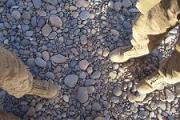All true.
Don't waste ammunition, effort and time trying to do a Recon by Fire, it'll be ineffective against anyone with even a little experience and will only serve to show the bad guys that their effort is having an effect and we're excessively nervous. There's a place for Recon by Fire but this isn't it. There's no place for the 'Mad Minute' bit...
Hopefully, US elms are using their ANA and ANP counterparts who have local sensitivity and better eyes for spotting bad guys in the rocks but we do have the advantage of being able to do a map recon -- assuming enough folks know how -- and deducing likely sniper and ambush locations on a route so that actions and reactions can be anticipated.
Surely every elm in country is doing their best to avoid establishing ANY pattern, are using different routes out and back EVERY time and know that any habitation will contain observers who report our movements, as possibly will any otherwise innocent who happen to see us. We will never match the locals in terrain knowledge or in patience but we can use their terrain to our advantage and negate their patience advantage by doing the unexpected -- always.
I suspect that the rediscovery by the bad guys in the 'Stan that the SMLE / Dragunoiv or whatever is a good stand off effort is aimed precisely at doing what it appears to be doing -- make people excessively nervous for no real benefit. The Troops will work it out if their Bosses do not over worry it.
One of the likely problems, I'm inclined to believe, is that some current technology allows one to 'fix' the location of a distant shooter. That can and likely does cause target fixation on the part of the Boomerang or other techno gadget owner which can lead to a lot of effort being expended to chase a ghost.
OTOH, if you have a bad shooter nearby, one who fires at you but hits nothing, best to leave him alone lest he be replaced by someone who does better. Seriously. I've seen that happen several times, once to include Gunships and an air strike on a guy who had hit no one in two days. Go getters sometimes go and get the wrong things...

Life is simpler in a conventional war, one just drops a round or two from nearby Arty or Mortars.

ADDED: Jcustis snuck in on me -- he and Chris are both right,the 'solution' is simply better training.




 Reply With Quote
Reply With Quote













Bookmarks